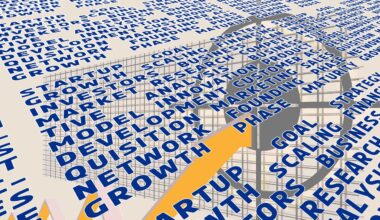Inflation vs. Deflation: What’s the Difference?
Understanding inflation and deflation is crucial for financial literacy. These two economic concepts influence purchasing power, prices, and overall economic stability. Inflation occurs when prices for goods and services rise over time while purchasing power declines. Conversely, deflation signifies a decrease in the overall price level of goods and services. Both phenomena have significant implications for consumers and businesses. When inflation is high, consumers may delay purchases, expecting further price hikes. During deflation, companies may reduce production, anticipating lower demand and diminished prices. Recognizing trends in inflation and deflation enables individuals to make informed financial decisions. Investors also closely monitor these trends, adjusting their portfolios based on expected economic shifts. A robust understanding of these concepts can aid in effective budgeting and planning. Thus, grasping inflation and deflation fundamentals is essential in navigating modern financial landscapes. It empowers individuals to strategize savings, investments, and spending wisely. Awareness of their effects on the economy allows proactive financial management, ensuring better sustainability in personal finance. With a clear comprehension of these terms, one can effectively tackle financial challenges in daily life.
Inflation and deflation impact various aspects of the economy, including employment rates and interest rates. Inflation often leads to central banks increasing interest rates to control money supply and stabilize prices. Higher interest rates can dampen borrowing and spending, which may, in turn, lead to lower economic activity. In contrast, during deflation, central banks might lower interest rates to encourage loans and investments, aiming to stimulate economic growth. Both inflation and deflation significantly affect personal finance management, especially savings and investments. Individuals must understand how these conditions influence their financial priorities. For instance, when inflation rises, retaining purchasing power is vital, pushing individuals to invest in assets that typically appreciate in value, like real estate or stocks. Alternatively, during deflationary periods, it is often wise to maintain liquidity to seize opportunities arising from falling prices. This understanding helps tailor financial strategies to the prevailing economic situation. Proper planning reduces the impact of inflation on essential assets while taking advantage of the possibilities in a deflationary environment. Developing strategies around these economic indicators will ensure sustainable financial habits and greater financial security.
The Causes of Inflation
Inflation can result from various factors, often categorized as demand-pull and cost-push inflation. Demand-pull inflation occurs when there is increased demand for goods and services, surpassing production capability. This heightened demand can be driven by economic growth, increased consumer spending, or government expenditure. Consequently, suppliers raise prices to balance supply with demand. On the other hand, cost-push inflation stems from increases in the costs of production, including raw materials and labor. When producers face higher costs, these costs often get passed on to consumers through increased prices. Additionally, external factors such as geopolitical situations, natural disasters, and global market trends can also instigate inflation. When businesses encounter supply chain disruptions, they may face additional costs. Understanding these causes provides valuable insight into inflation management. Policymakers can formulate effective strategies to combat inflation by addressing either demand or production cost issues. It is critical for individuals to stay informed about the factors causing inflation. This knowledge empowers individuals to adjust their financial strategies accordingly, ensuring preparedness for the ever-changing economic landscape.
Understanding deflation’s causes also plays a vital role in financial literacy. Deflation occurs when there is a sustained decline in prices across the economy due to reduced consumer demand or surplus goods. This lack of demand can arise from various factors, including high unemployment rates, economic recessions, or technological advancements that lower production costs. When consumers expect prices to fall, they may postpone purchases, leading to decreased economic activity. Consequently, companies might cut back on production, leading to further job losses and amplifying the deflationary cycle. Technological progress, often heralded for efficiency, can also contribute to deflation by lowering production costs. However, prolonged deflation can be harmful to the economy, as it can lead to increased debt burdens and reduced consumer spending. Thus, understanding these factors aids in developing strategies to cope with deflationary periods. By staying informed about economic conditions, individuals can make prudent decisions regarding their finances. This awareness fosters adaptability in their investment strategies, ensuring effectiveness during fluctuating market environments. Ultimately, a solid grasp of deflation is equally essential for maintaining financial health.
Effects of Inflation on Consumers
The effects of inflation on consumers can be profound and wide-reaching. Rising prices can erode purchasing power, making it challenging for individuals to maintain their standard of living. As inflation increases, consumers find themselves can afford fewer goods and services, which can lead to changes in spending habits. Many may prioritize basic necessities over non-essential items, shifting demand in the marketplace. Additionally, inflation can disproportionately affect different income groups, with those on fixed incomes being hit hardest. Individuals with lower incomes may struggle to keep up with rising prices, which can exacerbate economic inequality. Understanding the implications of inflation enables consumers to prepare and adapt their financial strategies effectively. It may prompt them to invest in assets that tend to grow in value during inflationary periods, preserving their purchasing power. Moreover, knowledge of inflation allows consumers to budget more accurately and consider long-term financial planning. Awareness of inflationary trends also informs consumers when to make significant purchases or investments, optimizing their financial outcomes. Adapting to inflation is crucial for maintaining financial stability and achieving personal financial goals.
Deflation, on the other hand, can have its own set of effects on consumers. Although falling prices may seem beneficial at first glance, prolonged deflation can lead to significant economic challenges. Consumers may delay purchases during deflation, anticipating even lower prices in the future. This behavior can create a reduced demand for goods and services, prompting businesses to decrease production. The cascading effect can lead to layoffs and increased unemployment, ultimately harming the overall economy. Those with fixed debts may find themselves in further financial strife, as their debt’s real value increases in a deflationary environment. Understanding the ramifications of deflation is crucial for individuals to navigate economic challenges strategically. With this knowledge, consumers can balance their savings and spending to weather economic storms effectively. Identifying opportunities during deflationary times, such as purchasing undervalued assets, can lead to potential long-term gains. Overall, recognizing the complexities of deflation fosters a deeper awareness of personal finance and investments amidst changing economic conditions. This understanding becomes an essential tool in adapting financial planning and ensuring sustainable financial health.
Conclusion
Ultimately, the stark differences between inflation and deflation underscore the importance of financial literacy in navigating the economy. As these economic concepts continuously evolve, it is vital for individuals to familiarize themselves with their implications. The impact of inflation on purchasing power can lead to dramatic shifts in consumer behavior, investment strategies, and overall financial well-being. Conversely, understanding deflation’s challenges is equally essential, as prolonged deflation can prompt changes in spending habits and economic activity. Knowledge of these concepts equips individuals with the necessary tools to address their finances intelligently. Engaging in continuous financial education helps prepare individuals for potential economic fluctuations by guiding them through adjusting their financial plans. By recognizing when to save, spend, or invest wisely, individuals can mitigate risks associated with inflation and deflation. Thus, developing a comprehensive understanding of these economic phenomena ultimately fosters resilience within personal finance management. Staying informed about inflation and deflation ensures that consumers can make strategic financial decisions to improve their long-term economic stability and success.
To conclude, the concepts of inflation and deflation represent fundamental aspects of our economic landscape. A well-rounded comprehension of these phenomena not only enhances individual financial literacy but also empowers one to make informed financial decisions. By differentiating between inflation’s demand-pull and cost-push varieties and understanding what causes deflation, consumers can craft more effective financial strategies. Likewise, being aware of the effects these conditions have on purchasing power, spending behavior, and economic growth allows for better planning and investment decisions. Continuous awareness and education about inflation and deflation provide practical insights into adapting personal finances for changing economic environments. Individual adaptation enhances financial stability and contributes to broader economic resilience. Thus, enhancing one’s financial literacy involves not just understanding inflation and deflation but also applying that knowledge to real-life situations. Developing strategies to combat inflation, such as focusing on appreciating assets, or preparing for deflation by maintaining liquidity, can significantly affect a person’s financial future. In doing so, individuals place themselves in a position of strength amid fluctuating markets, paving the way for sustainable financial health.


